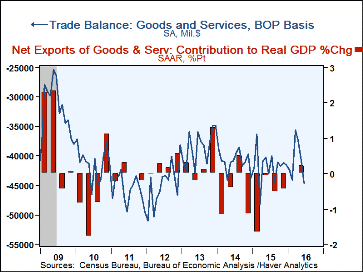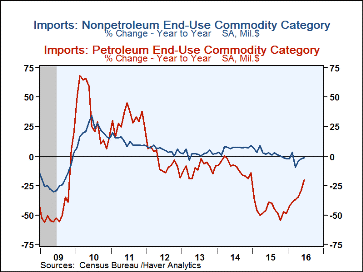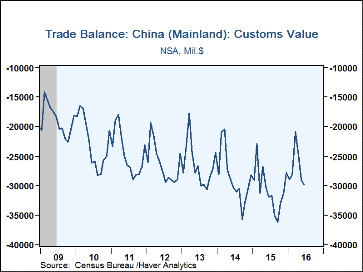 Global| Aug 05 2016
Global| Aug 05 2016U.S. Trade Deficit Widens with Rise in Petroleum Imports
Summary
The U.S. trade deficit in goods and services widened to $44.5 billion in June from a slightly revised $41.0 billion in May. The Action Economics Forecast Survey had expected a $43.1 billion deficit. The latest deficit was the largest [...]
The U.S. trade deficit in goods and services widened to $44.5 billion in June from a slightly revised $41.0 billion in May. The Action Economics Forecast Survey had expected a $43.1 billion deficit. The latest deficit was the largest since August 2015. It is the result of a 0.3% increase in exports (-3.8% y/y) and a 1.9% rise in imports (-2.4% y/y). Within imports, petroleum end-use goods grew 19.4% (-20.6% y/y) and nonpetroleum goods rose 1.9% (-1.5% y/y).
Among exports, goods rose 0.5% (-5.5% y/y). This featured a 5.7% gain in foods, feeds & beverages (2.1% y/y), with lesser increases in consumer goods, 2.7% (-3.8% y/y) and capital goods, 0.8% (-3.4% y/y). Autos & parts continued to decline, this month by 3.4% (-4.3% y/y), while "other" goods fell 2.2% (-0.8% y/y) and industrial materials & supplies were off 0.3% (-11.8% y/y). Exports of services edged higher 0.1% (-0.3% y/y), with a 3.6% (15.5% y/y) advance in maintenance & repair and 1.3% (0.4% y/y) in finance. There were declines in travel, which fell 0.8% in June (-0.4% y/y) and intellectual property charges, which fell 0.4% (-5.2% y/y).
Imports of goods increased 2.3% (-3.2% y/y) as industrial supplies & materials imports surged 6.9% (-12.0% y/y). As noted above, petroleum imports rose markedly, and the value of energy-related petroleum imports surged 23.8% (-20.0% y/y); the cost per barrel of crude oil was $39.38, up $5.19 from May. The quantity of energy-related product imports rebounded as well, up 9.9% (+9.8% y/y) after their decline in May. Nonauto consumer goods imports continued higher, rising another 3.9% (-0.9% y/y) and capital goods were up 2.1% (unchanged y/y). Foods, feeds & beverages fell 3.1% in the month (-5.5% y/y), autos were down 1.9% (-4.7% y/y) and "other" goods fell 1.1% (-1.6% y/y). Services imports eased 0.5% (+1.6% y/y), with travel off 1.2% (+7.1% y/y), transport down 1.1% (+1.8% y/y) and intellectual property charges down 0.5% (-0.5% y/y). As with exports, maintenance & repair had a noticeable increase, 1.4% (7.9% y/y).
By country, the trade deficit with mainland China widened a bit further to $29.8 billion in June from $29.0 billion in May. Exports rose, by 3.6% (-8.3% y/y) and imports also rose, by 2.8% (-6.0% y/y). Exports to Japan fell back by 1.1% (-1.1% y/y) after their surge in May but imports rebounded by 11.7% (+5.0% y/y), reversing their May decline. The trade deficit with the European Union narrowed slightly to $12.8 billion from $13.4 billion. Exports and imports both increased, exports by 7.8% (4.0% y/y) and imports by 3.4% (-2.1% y/y. Within that group, the balance with the U.K. in June, which is the last pre-Brexit reading, was a tiny surplus of $73 million; U.S. exports to the U.K. jumped 18.2% (-5.4% y/y), reversing a May decline, while imports from the U.K. were also up, by 9.4% (-10.3% y/y).
The international trade data can be found in Haver's USECON database. Detailed figures are available in the USINT database. The expectations figures are from the Action Economics Forecast Survey, which is carried in the AS1REPNA.
| Foreign Trade in Goods & Services (Current Dollars) | Jun | May | Apr | Y/Y | 2015 | 2014 | 2013 |
|---|---|---|---|---|---|---|---|
| U.S. Trade Deficit | $44.5 bil. | $41.0 bil. | $37.4 bil. | $43.0 bil. (6/15) |
$500.4 bil. | $490.2 bil. | $461.9 bil. |
| Exports of Goods & Services (% Chg) | 0.3 | -0.1 | 1.4 | -3.8 | -4.9 | 3.6 | 3.4 |
| Imports of Goods & Services (% Chg) | 1.9 | 1.6 | 2.0 | -2.4 | -3.7 | 4.0 | 0.0 |
| Petroleum (% Chg) | 19.4 | 8.4 | 5.0 | -20.6 | -45.5 | -9.6 | -11.0 |
| Nonpetroleum Goods (% Chg) | 1.2 | 1.5 | 2.2 | -1.5 | 2.2 | 6.5 | 2.0 |
Carol Stone, CBE
AuthorMore in Author Profile »Carol Stone, CBE came to Haver Analytics in 2003 following more than 35 years as a financial market economist at major Wall Street financial institutions, most especially Merrill Lynch and Nomura Securities. She has broad experience in analysis and forecasting of flow-of-funds accounts, the federal budget and Federal Reserve operations. At Nomura Securites, among other duties, she developed various indicator forecasting tools and edited a daily global publication produced in London and New York for readers in Tokyo. At Haver Analytics, Carol is a member of the Research Department, aiding database managers with research and documentation efforts, as well as posting commentary on select economic reports. In addition, she conducts Ways-of-the-World, a blog on economic issues for an Episcopal-Church-affiliated website, The Geranium Farm. During her career, Carol served as an officer of the Money Marketeers and the Downtown Economists Club. She has a PhD from NYU's Stern School of Business. She lives in Brooklyn, New York, and has a weekend home on Long Island.









